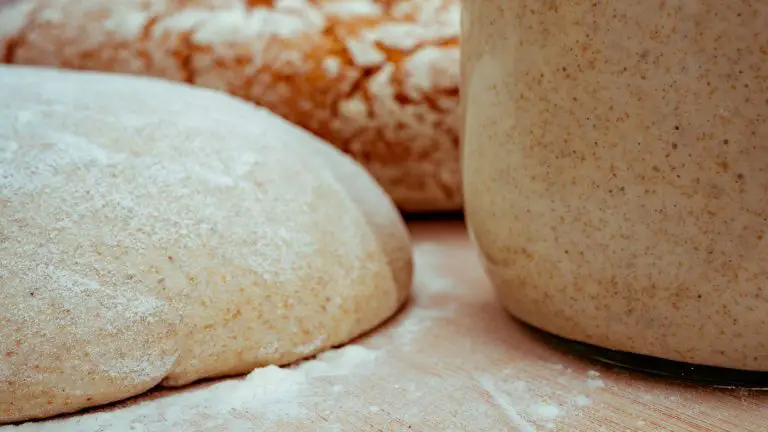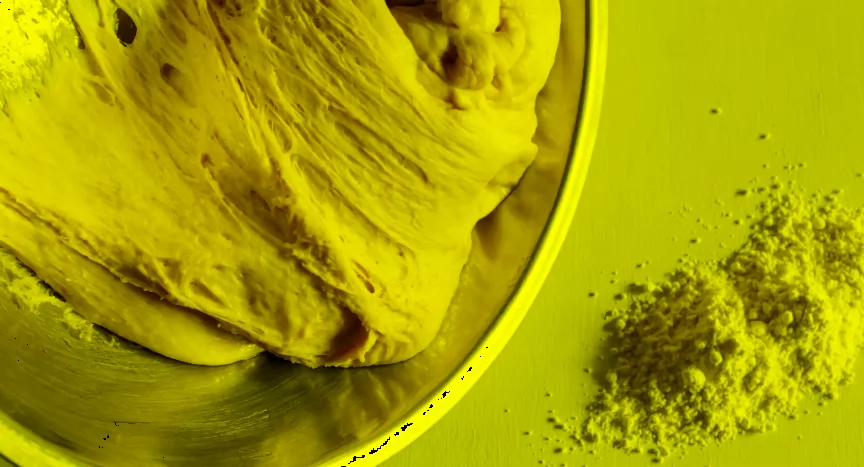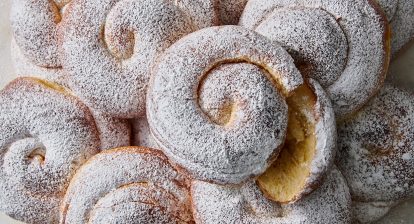Hydration is an important element in sourdough baking. If you're wondering how to produce the perfect textured bread with a crisp crust that lasts for days, then here's what you need to know!

Table of Contents

For the sourdough starter
- 150 gr water
- 162/5 g flour (rye flour, whole wheat flour or all-purpose flour)
For the dough
- 600 gr bread flour
- 360 g water
- 180 g active sourdough starter
- 10 g salt
- Rice flour for dusting
Make the sourdough starter
- In the morning, add 100 g of water and 80 g of flour to a jar and then close it loosely.
- Let the mixture sit at room temperature until it starts to bubble to the surface.
- After 7 hours, feed the starter with 50 g of water; and 62.5 grams of flour. Then let it rest overnight.
Make the dough
- The next day, mix in the bread flour; and 360 g of water in a bowl. Cover with plastic wrap and autolyze for 3 hours.
- Then add the initial 180 g of highly hydrated sourdough to the mixture.
- Cover with plastic wrap and let the dough rest for 1 hour.
- Sprinkle salt over the dough. Stretch and fold the dough to incorporate the salt.
- Cover the dough and let it stand for 3 hours in mass fermentation.
- Every 30 minutes stretch and fold the dough in the center, in the shape of a ball.
Form the dough in advance
- Transfer the dough to an unfloured work surface and move the dough around to form a ball and create tension.
- Cover the ball of dough with an inverted bowl and let it rest for 30 minutes.
Form the dough
- Dust a cover basket, otherwise called insulation, with rice flour.
- Using a pastry scraper, roll the dough so the seam side is facing you.
- Gently stretch and fold the bottom of the dough to the middle.
- Extend and fold the right side of the dough in the middle, then repeat with the left and top side of the dough.
- Pull the corners of the dough towards the center.
- Then, transfer the formed dough to a floured basket.
- Cover the dough and refrigerate overnight.
Bake the bread
- The next day, remove the dough from the refrigerator. Place a Dutch oven or a deep cast iron skillet with a lid in the oven.
- Preheat oven to 450 degrees F for 1 hour.
- Place a piece of parchment paper on a work surface and gently pour the dough over it.
- Cut the bread with a sharp knife and place the bread in the preheated baking dish.
- Cover and bake for 20 minutes to achieve oven spring.
- We uncover it and bake it for another 30 minutes.
- Transfer to a wire rack to cool.
- Cooking time: 50 min
- Category: bread
What is Hydration?
Hydration is the term used to describe the amount of water or liquid in sourdough. The higher the water content, the higher the hydration percentage.
A high hydration sourdough starts with a the type of sourdough starter called levain, which is basically a combination of sourdough starter, water and flour. This type of dough produces softer breads; with an open crumb; and a thin crust that stays fresh longer.
Why are hydration levels important in sourdough?
The hydration level of your sourdough affects the type of bread you end up with. It determines the appearance and texture of your bread and shows how the dough will react to mixing, fermentation and shaping.
The fermenting nature of sourdough often results in a tighter crumb, which is why sourdough breads are often made with high hydration dough.
Low hydration dough
The lower the hydration, the stiffer the dough, which means you'll have to work harder to incorporate the ingredients. In addition, gluten development will take longer, which means more stirring.
Although the dough will also be less sticky and easier to handle, the fermentation process will be longer.

Dough with higher hydration
The higher the hydration, the weaker and softer the dough will be. This means that the ingredients will combine more easily, and the dough will be wetter, stickier and generally easier to handle.
Little or no agitation will be required, as the extra moisture will allow yeast and bacteria to roam free. A highly hydrated dough will ferment much faster, although dough sticking will require advanced level skills to handle.
If you are a beginner baking sourdough bread, it is better to start with low hydration dough. Then gradually increase its hydration as your skills develop, to produce delicious bread.

How hydration levels affect bread
Hydration levels affect both your dough and the outcome of your bread. Some of the ways your bread can be affected by increased hydration levels include:
- textures – A highly hydrated dough will produce a soft-textured noodle with an open crumb that reveals bigger holes in sourdough bread.
- crust – The crust of a sourdough bread is normally thick and firm, although a sourdough with higher hydration has a thinner crust that stays crispy longer.
- Taste – Breads with high hydration have a developed sour dough tastewhile dough with lower hydration produces a sourness like vinegar.
- The exterior – A high-moisture loaf won't make a long loaf, although you can bake it in a loaf pan if you're looking for a well-done loaf.
High Hydration Dough Bread Recipe
it high hydration sourdough The bread recipe is perfect for any time of the day. Just bake, cool and shred to enjoy whenever you want!
Ingredients
For the sourdough starter
- 150 g of water
- 162/5 g flour (rye flour, whole wheat flour or all-purpose flour)
For the dough
- 600 g of bread flour
- 360 g of water
- 180 gr active sourdough starter
- 10 g of salt
- Rice flour for dusting

GUIDELINES
- Make the sourdough starter: In the morning, add 100 g of water and 80 g of flour to a jar, then close it loosely.
- Let the mixture sit at room temperature until it starts to bubble to the surface.
- After 7 hours, feed the starter with 50 g of water; and 62.5 grams of flour. Then let it rest overnight.
- Make the dough: The next day mix the bread flour; and 360 g of water in a bowl. Cover with plastic wrap and autolyze for 3 hours.
- Then add the initial 180 g of highly hydrated sourdough to the mixture.
- Cover with plastic wrap and let the dough rest for 1 hour.
- Sprinkle salt over the dough. Stretch and fold the dough to incorporate the salt.
- Cover the dough and let it stand for 3 hours in mass fermentation.
- Every 30 minutes stretch and fold the dough in the center, in the shape of a bule.
- Form the dough in advance: Transfer the dough to an unfloured work surface and move the dough around to form a ball and create tension.
- Cover the ball of dough with an inverted bowl and let it rest for 30 minutes.
- Form the dough: Dust a banneton aka correction basket (or correction basket alternatives) with rice flour.
- Using one bench scraperroll the dough so that the seam side is facing you.
- Wet your hands: Gently stretch and fold the bottom of the dough to the middle.
- Extend and fold the right side of the dough in the middle, then repeat with the left and top side of the dough.
- Pull the corners of the dough towards the center.
- Then, transfer the formed dough to a floured basket.
- Cover the dough and refrigerate overnight.
- Bake the bread: The next day, remove the dough from the refrigerator. Country a Dutch oven or deep cast iron casserole with a lid in the oven.
- Preheat oven to 450F for 1 hour.
- Place a piece of parchment paper on a work surface and gently pour the dough over it.
- Mark the bread with a sharp knife and place the bread in the preheated baking dish.
- Cover and bake for 20 minutes to achieve oven spring.
- We uncover it and bake it for another 30 minutes.
- Transfer to a wire rack to cool.
So, high hydration sourdough?
For a moist, tender dumpling with a crispy crust, choose a high-hydration dough in your sourdough recipe. However, if you prefer the look over the taste, then reduce the amount of liquid in the recipe.
Frequently asked questions
What does higher hydration do to sourdough?
The higher the hydration level of your dough, the softer the texture of the bread will be, with a wider crumb.
Is high hydration dough better?
High hydration in sourdough bread is much better as this will create an open crumb structure, with a thin, crisp crust.
Does high hydration dough ferment faster?
Yes, the higher the hydration the faster the fermentation. This means that if your dough is 85% hydrated, it will ferment much faster than a dough that is 75% hydrated.
How do you make dough 100% moisturizing?
To make 100% hydrated sourdough, simply mix 1/2 cup starter with 1 cup flour and 1/2 cup water.







